-
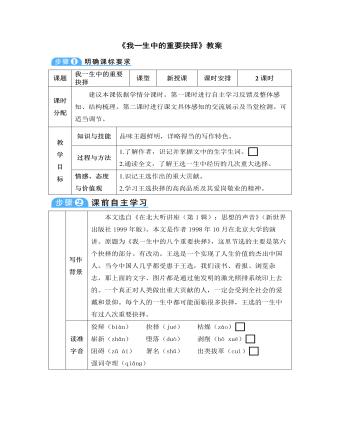
部编版语文八年级下册《我一生中的重要抉择》教案
(1)一个快落山的太阳,跟大家讲的,更多的是自己一生奋斗过来的体会。指61岁的老人。(2)加入人家说我是权威,也许还马马虎虎。作者自谦的说法,指成绩还过得去。(3)明明是一个过去时态,大家误认为是现在时态。指作者认为自己不适合再做权威了。(4)扶植年轻人我觉得是一种历史的潮流,当然我们要创造条件,就是把他们推到需要刺激的风口浪尖上。比喻重要的岗位或市场的前沿。【感悟精彩句子】1.所以我知道自己是一个下午四五点钟的太阳。各位呢,上午八九点钟的太阳,这是本科生;硕士生呢,九十点钟的太阳;博士生呢,十点十一点钟的太阳。比喻,拉近了与听众的距离,倍感亲切、期望和鼓舞。2.所以1992年前电视台采访我,我基本上都拒绝了。透过细节,体现了坚持不懈的科研精神。

部编版语文八年级下册《在长江源头各拉丹冬》教案
【深入研读,探究方法】1.语言优美,通俗易懂,妙笔生花。文章中运用“静穆”“晶莹”“熠熠烁烁”这些优美鲜活的词语,生动形象地描绘了各拉丹冬的千姿百态,壮观奇景,使文章更加的灵动,给人以无限美感。作者以自己的游览经历讲述,语言平实,浅显易懂。2.主题鲜明,意味深长。文章主要讲述作者的一次雪域高原之游,描写了各拉丹冬美丽壮观的景色和作者攀登的经历,给我们以启示:做任何事情要不放弃,不半途而废,勇往直前就能达到自己想要的目标。3.善用比喻,生动形象。文中处处可见比喻的修辞手法,“阳光……巨人” “像长发披肩”都运用了比喻的修辞手法,使各拉丹冬的景色更生动具体,富有感染力,给人以深刻的印象,引发读者的联想和想象。
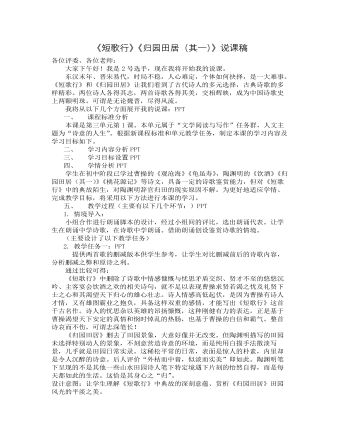
《短歌行》《归园田居》说课稿 2021-2022学年统编版高中语文必修上册
3. 教学任务二:PPT子任务一、二、三感悟诗情:那么为什么不能轻易对诗人诗歌进行删减呢?除了诗歌语言及内容方面的影响外,还有重要的一点就是:感情。情感是诗歌的尺度,而非长短。下面将从知人论世的角度再读诗歌。重点赏析曹操的“忧”与“解”和陶渊明的“误”与“归”。通过编写诗人年谱的方式,呈现诗人的各个人生阶段的经历和当时的时代背景,让诗人回到历史现场,让自己代入诗人境遇,以意逆志。通过查阅资料和编写年谱,可以了解到:曹操既能横槊,又能赋诗,如曹丕在《典论·自叙》中所说:“上(曹操)雅好诗文书籍,虽在军旅,手不释卷。”《短歌行》中多用典故和善用比兴或许就源于此。其次,曹操虽出身仕宦,但门第不算高贵,这样的家庭地位让他有着出人头地、建功立业的迫切愿望,因此,“唯才是举”是曹操出于现实的理性选择。再次,曹操写《短歌行》的确切时间已难考证,如取赤壁大战前的说法,曹操已五十四岁,来日无多的紧迫感、贤才归附的愿望自然尤为强烈。
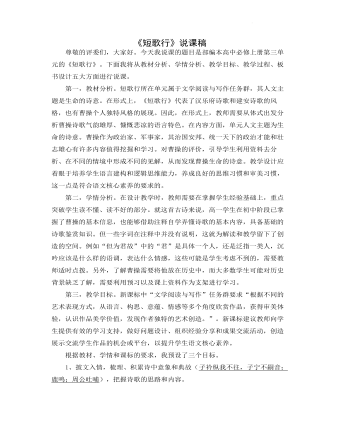
《短歌行》说课稿2022-2023学年统编版高中语文必修上册
第二课时为知人。即利用预习所查到的资料、学生之间的分享以及教师预备的材料,合作探究三个问题:曹操为何如此渴望贤才?天下归心的愿望是否实现?如何评价曹操?本课时采用创设情境的方式,从刘备、曹丕、晚年曹操等多重角度评价曹操,自领角色,利用资料有逻辑地证明自己的观点。教师出示不同学者评价,师生共同研讨评价的技巧和原则,尝试写作短小文学评论。这是解决忧的果。第三课时为回味。创设诵读比赛的情境,在比赛和评价中研讨标点符号的作用,如何读出曹操诗歌独特的特点,以及带着对曹操的认识读出自己的理解。(每组评出最佳朗读者和最佳评论员,上传优秀视频)。这是为了让学生最后读出忧。第五,板书设计。以上是我本节课教学设计的板书,体现了分析本首诗的基本思路和学习方法。
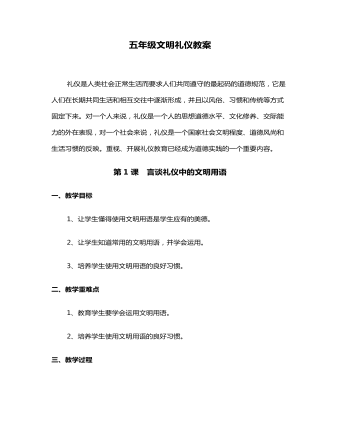
五年级礼仪课教学教材教案
一、教学目标1、让学生懂得使用文明用语是学生应有的美德。2、让学生知道常用的文明用语,并学会运用。3、培养学生使用文明用语的良好习惯。

新人教版高中英语必修3Unit 1 Festivals and celebrations-Discovering Useful Structure教学设计
4.That was an experience that frightened everyone. →That was _____________________. 答案:1. taking 2. being discussed 3. in the reading room 4. a frightening experienceStep 6 The meaning and function of V-ing as the predicative动词-ing形式作表语,它通常位于系动词后面,用以说明主语“是什么”或“怎么样”一种表示主语的特质、特征和状态, 其作用相当于形容词; 另一种具体说明主语的内容, 即主语等同于表语, 两者可互换。The music they are playing sounds so exciting. 他们演奏的音乐听起来令人激动。The result is disappointing. 结果令人失望。Our job is playing all kinds of music. 我们的工作就是演奏各种音乐。Seeing is believing. 眼见为实。Step 7 Practice1. It is ________(amaze) that the boy is able to solve the problem so quickly.2. Buying a car is simply _______(waste) money. 3. Please stop making the noise—it’s getting ________(annoy). 4. complete the passage with the appropriate -ing form.La Tomatina is a festival that takes place in the Spanish town Bunol every August. I think many food festivals are __________ because people are just eating. however, this festival is _________ because people don't actually eat the tomatoes. Instead, they throw them at each other! the number of people ________ part in this tomato fight, can reach up to 20,000, and it is a very __________ fight that lasts for a whole hour. The _______ thing is how clean Bunol is after the tomatoes are washed away after the fight. this is because the juice form tomatoes is really good for making surfaces clean!答案:1. amazing 2. wasting 3. annoying4. boring interesting taking exciting amazing

新人教版高中英语必修3Unit 1 Festivals and Celebrations-Reading and Thinking教学设计
The topic of this part is “Discover the reasons for festivals and celebrations.The Listening & Speaking & Talking part aims at talking about the experiences and feelings or emotions about the festivals and celebrations. This section aims at detecting the reason why the people celebrate the festivals, the time, the places, the types and the way of celebrations. It also explains why some traditions in the old celebrations are disappearing, like the firecrackers in the big cities and some new things are appearing like the prosperity of business or commerce. 1. Students can talk about what festivals they know and the reasons and the way of celebrating them.2. Students should learn the reading skills such as the headline and get the topic sentences, the structures of articles.3. Students can understand the past, the present situation of some festival around the world and why there are some changes about them. 4. Students can have the international awareness about the festivals.1. Students should learn the reading skills such as the headline and get the topic sentences, the structures of articles.2. Students can understand the past, the present situation of some festival around the world and why there are some changes about them.Step 1 Lead in---Small talkWhat festival do you like best ? Why ?I like the Spring Festivals because I can set off the fireworks, receive the lucky money and enjoy the Gala with my families.Step 2 Before reading---Pair workWhy do people celebrate different festivals ?The Spring Festivals is to celebrate the end of winter and the coming of spring and new life.The Mid-autumn Day is to celebrate the harvest and admire the moon.

新人教版高中英语必修3Unit 1 Festivals and Celebrations-Listening &Speaking&Talking教学设计
The theme of this section is “Talk about festival activities and festival experiences”.Festival and holiday is a relaxing and interesting topic for students. This part talks about the topic from the daily life of students’. In the part A ---Listening and Speaking, there are three conversations among different speakers from three countries(Japan, Rio and China), where the speakers are participating in or going to participate in the festivals and celebrations. So listening for the relationship among them is a fundamental task. Actually, with the globalization and more international communication, it is normal for Chinese or foreigners to witness different festivals and celebrations in or out of China. In the Conversation 1, a foreign reporter is interviewing a Japanese young girl who just had participated in the ceremony of the Coming-of-Age Day on the street and asking her feeling about the ceremony and the afterwards activities. Conversation 2, Chinese girl Li Mei is witnessing the Rio Carnival for the first time, and her friend Carla gives her some advice on the costumes which enables her to match with the carnival to have a good time. Conversation 3, a Chinese guide is showing a group of foreign visitors around the Lantern Festival and introducing the customs of the festival to them. The three conversations have a strong vitality and insert the festival and cultural elements from different countries. So perceiving the festivals and cultures from different countries is the second task. At the same time, the scripts also insert the targeted grammar --- v-ing as attributive and predicative, which students can perceive and experience in a real context and make a road for the further study. That is the third task. In the Part B--- Listening and Talking, the theme is “Talk about festival experience”, which is the common topic in our daily conversations. During the conversation, Song Lin, a Chinese student, asked Canadian friend Max about how to spend Christmas. In the conversation, Song Lin talked about experience and the feelings during the Chinese Spring Festival, during which there are not only some enjoyable things but some unpleasant things. After the listening, perhaps students find there are some similarities between Christmas and the Chinese Spring Festival as there are some differences in the origins and celebrations. For example, people always visit friends and relatives, decorate their houses, have a big dinner together, chat and give presents to each other.

新人教版高中英语必修3Unit 1 Festivals and Celebrations-Reading for Writing教学设计一
The topic of this part is “Write about your festival experience”.During the Listening and Speaking and Talking, students are just asked to say out their festival experiences such as the Spring Festival, Mid-autumn Day, but this part students will be asked to write down their own festival experiences. During the reading part, it introduces the Naadam Festival in Inner Mongolia Autonomous Region, which can give students a good example to imitate. Students not only learn the festival, but touch and feel the Inner Mongolian’s character, the spirit and cultural atmosphere, which can help students form the cultural awareness and learn to enjoy and value the diversity of Chinese culture.Concretely, the dairy tells the experience that the author spent the Naadam Festival in Inner Mongolia Autonomous Region with his/her friend. The structure is clear. In the opening paragraph, it introduces the topic of the Naadam Festival and the whole feeling. Then it introduces the items of the festival like the ceremony, wrestling and horse racing. Finally, it summarizes this experience. Because this part is a travel journal, we must guide students pay more attention to these details: 1. use the first person. 2. use the past tense to tell the past thing and use the present or future tense to describe the scenery. 3. use the timeline to tell the development. 4. be careful for the author’s psychology, emotion and feeling, etc.1. Read quickly to get main idea; read carefully to get the detailed information about Naadam Festival.2. Learn the structure of the reading article and language.3. Write an article about a festival experience4. Learn to use the psychology, emotions and feeling in the writing.1. Write an article about a festival experience.2. Use the structure of the reading article and language.

新人教版高中英语选修2Unit 1 Science and Scientists-Discovering useful structures教学设计
The grammatical structure of this unit is predicative clause. Like object clause and subject clause, predicative clause is one of Nominal Clauses. The leading words of predicative clauses are that, what, how, what, where, as if, because, etc.The design of teaching activities aims to guide students to perceive the structural features of predicative clauses and think about their ideographic functions. Beyond that, students should be guided to use this grammar in the context apporpriately and flexibly.1. Enable the Ss to master the usage of the predicative clauses in this unit.2. Enable the Ss to use the predicative patterns flexibly.3. Train the Ss to apply some skills by doing the relevant exercises.1.Guide students to perceive the structural features of predicative clauses and think about their ideographic functions.2.Strengthen students' ability of using predicative clauses in context, but also cultivate their ability of text analysis and logical reasoning competence.Step1: Underline all the examples in the reading passage, where noun clauses are used as the predicative. Then state their meaning and functions.1) One theory was that bad air caused the disease.2) Another theory was that cholera was caused by an infection from germs in food or water.3) The truth was that the water from the Broad Street had been infected by waste.Sum up the rules of grammar:1. 以上黑体部分在句中作表语。2. 句1、2、3中的that在从句中不作成分,只起连接作用。 Step2: Review the basic components of predicative clauses1.Definition

新人教版高中英语选修2Unit 1 Science and Scientists-Learning about Language教学设计
Step 7: complete the discourse according to the grammar rules.Cholera used to be one of the most 1.__________ (fear) diseases in the world. In the early 19th century, _2_________ an outbreak of cholera hit Europe, millions of people died. But neither its cause, 3__________ its cure was understood. A British doctor, John Snow, wanted to solve the problem and he knew that cholera would not be controlled _4_________ its cause was found. In general, there were two contradictory theories 5 __________ explained how cholera spread. The first suggested that bad air caused the disease. The second was that cholera was caused by an _6_________(infect) from germs in food or water. John Snow thought that the second theory was correct but he needed proof. So when another outbreak of cholera hit London in 1854, he began to investigate. Later, with all the evidence he _7_________ (gather), John Snow was able to announce that the pump water carried cholera germs. Therefore, he had the handle of the pump _8_________ (remove) so that it couldn't be used. Through his intervention,the disease was stopped in its tracks. What is more, John Snow found that some companies sold water from the River Thames that __9__________________ (pollute) by raw waste. The people who drank this water were much more likely _10_________ (get) cholera than those who drank pure or boiled water. Through John Snow's efforts, the _11_________ (threaten) of cholera around the world saw a substantial increase. Keys: 1.feared 2.when 3. nor 4.unless 5.that/which 6.infection 7.had gathered 8.removed 9.was polluted 10.to get 11. threat

新人教版高中英语选修2Unit 1 Science and Scientists-Reading and thinking教学设计
Step 5: After learning the text, discuss with your peers about the following questions:1.John Snow believed Idea 2 was right. How did he finally prove it?2. Do you think John Snow would have solved this problem without the map?3. Cholera is a 19th century disease. What disease do you think is similar to cholera today?SARS and Covid-19 because they are both deadly and fatally infectious, have an unknown cause and need serious public health care to solve them urgently.keys:1. John Snow finally proved his idea because he found an outbreak that was clearly related to cholera, collected information and was able to tie cases outside the area to the polluted water.2. No. The map helped John Snow organize his ideas. He was able to identify those households that had had many deaths and check their water-drinking habits. He identified those houses that had had no deaths and surveyed their drinking habits. The evidence clearly pointed to the polluted water being the cause.3. SARS and Covid-19 because they are both deadly and fatally infectious, have an unknown cause and need serious public health care to solve them urgently.Step 6: Consolidate what you have learned by filling in the blanks:John Snow was a well-known _1___ in London in the _2__ century. He wanted to find the _3_____ of cholera in order to help people ___4_____ it. In 1854 when a cholera __5__ London, he began to gather information. He ___6__ on a map ___7___ all the dead people had lived and he found that many people who had ___8____ (drink) the dirty water from the __9____ died. So he decided that the polluted water ___10____ cholera. He suggested that the ___11__ of all water supplies should be _12______ and new methods of dealing with ____13___ water be found. Finally, “King Cholera” was __14_____.Keys: 1. doctor 2. 19th 3.cause 4.infected with 5.hit 6.marked 7.where 8.drunk 9.pump 10.carried 11.source 12.examined 13.polluted 14.defeatedHomework: Retell the text after class and preview its language points

新人教版高中英语选修2Unit 1 Science and Scientists-Using langauge教学设计
This happens because the dish soap molecules have a strong negative charge, and the milk molecules have a strong positive charge. Like magnets, these molecules are attracted to each other, and so they appear to move around on the plate, taking the food coloring with them, making it look like the colors are quickly moving to escape from the soap.Listening text:? Judy: Oh, I'm so sorry that you were ill and couldn't come with us on our field trip. How are you feeling now? Better?? Bill: Much better, thanks. But how was it?? Judy: Wonderful! I especially liked an area of the museum called Light Games.it was really cool. They had a hall of mirrors where I could see myself reflected thousands of times!? Bill: A hall of mirrors can be a lot of fun. What else did they have?? Judy: Well, they had an experiment where we looked at a blue screen for a while, and then suddenly we could see tiny bright lights moving around on it. You'll never guess what those bright lights were!? Bill: Come on, tell me!? Judy: They were our own blood cells. For some reason, our eyes play tricks on us when we look at a blue screen, and we can see our own blood cells moving around like little lights! But there was another thing I liked better. I stood in front of a white light, and it cast different shadows of me in every color of the rainbow!? Bill: Oh, I wish I had been there. Tell me more!? Judy: Well, they had another area for sound. They had a giant piano keyboard that you could use your feet to play. But then, instead of playing the sounds of a piano, it played the voices of classical singers! Then they had a giant dish, and when you spoke into it, it reflected the sound back and made it louder. You could use it to speak in a whisper to someone 17 meters away.? Bill: It all sounds so cool. I wish I could have gone with you? Judy: I know, but we can go together this weekend. I'd love to go there again!? Bill: That sounds like a great idea!
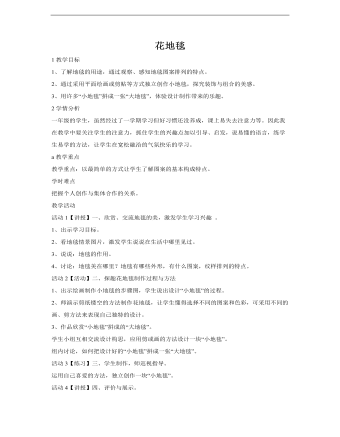
小学美术人教版一年级下册《第3课花地毯》教学设计
2学情分析一年级的学生,虽然经过了一学期学习但好习惯还没养成,课上易失去注意力等。因此我在教学中要关注学生的注意力,抓住学生的兴趣点加以引导、启发,说易懂的语言,练学生易学的方法,让学生在宽松融洽的气氛快乐的学习。a教学重点教学重点:以最简单的方式让学生了解图案的基本构成特点。学时难点把握个人创作与集体合作的关系。
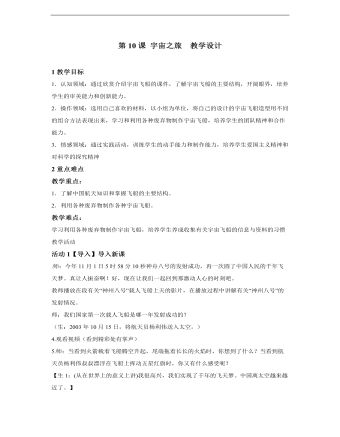
小学美术人教版六年级下册《第10课宇宙之旅》教学设计
2重点难点教学重点:1.了解中国航天知识和掌握飞船的主要结构。2.利用各种废弃物制作各种宇宙飞船。教学难点:学习利用各种废弃物制作宇宙飞船,培养学生养成收集有关宇宙飞船的信息与资料的习惯教学活动活动1【导入】导入新课.师:今年11月1日5时58分10秒神舟八号的发射成功,再一次圆了中国人民的千年飞天梦。真让人振奋啊!好,现在让我们一起回到那激动人心的时刻吧。教师播放在段有关“神州八号”载人飞船上天的影片,在播放过程中讲解有关“神州八号”的发射情况。
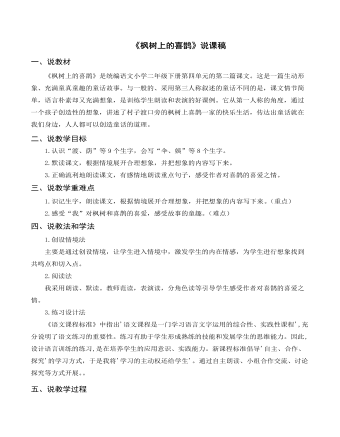
(说课稿)《枫树上的喜鹊》部编人教版二年级上册语文
二、说教学目标1.认识“渡、荫”等9个生字,会写“伞、姨”等8个生字。 2.默读课文,根据情境展开合理想象,并把想象的内容写下来。? 3.正确流利地朗读课文,有感情地朗读重点句子,感受作者对喜鹊的喜爱之情。三、说教学重难点1.识记生字,朗读课文,根据情境展开合理想象,并把想象的内容写下来。(重点) 2.感受“我”对枫树和喜鹊的喜爱,感受故事的童趣。(难点)四、说教法和学法1.创设情境法主要是通过创设情境,让学生进入情境中,激发学生的内在情感,为学生进行想象找到共鸣点和切入点。? 2.阅读法我采用朗读、默读。教师范读,表演读,分角色读等引导学生感受作者对喜鹊的喜爱之情。3.练习设计法《语文课程标准》中指出'语文课程是一门学习语言文字运用的综合性、实践性课程',充分说明了语文练习的重要性。练习有助于学生形成熟练的技能和发展学生的思维能力。因此,设计语言训练的练习,是在培养学生的应用意识、实践能力。新课程标准倡导'自主、合作、探究'的学习方式,于是我将'学习的主动权还给学生'。通过自主朗读、小组合作交流、讨论探究等方式开展。
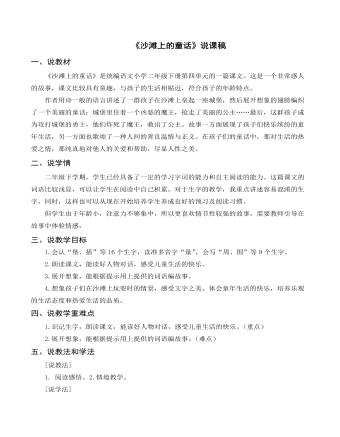
(说课稿)《沙滩上的童话》部编人教版二年级上册语文
一、说教材《沙滩上的童话》是统编语文小学二年级下册第四单元的一篇课文。这是一个非常感人的故事,课文比较具有童趣,与孩子的生活相贴近,符合孩子的年龄特点。 作者用诗一般的语言讲述了一群孩子在沙滩上垒起一座城堡,然后展开想象的翅膀编织了一个美丽的童话:城堡里住着一个凶恶的魔王,抢走了美丽的公主……最后,这群孩子成为攻打城堡的勇士,他们炸死了魔王,救出了公主。故事一方面展现了孩子们快乐缤纷的童年生活,另一方面也歌颂了一种人间的善良温情与正义。在孩子们的童话中,那对生活的热爱之情,那纯真地对他人的关爱和帮助,尽显人性之美。二、说学情二年级下学期,学生已经具备了一定的学习字词的能力和自主阅读的能力。这篇课文的词语比较浅显,可以让学生在阅读中自己积累。对于生字的教学,我重点讲述容易混淆的生字,同时,这样也可以从现在开始培养学生养成良好的预习及阅读习惯。 但学生由于年龄小,注意力不够集中,所以更喜欢情节性较强的故事,需要教师引导在故事中体验情感。
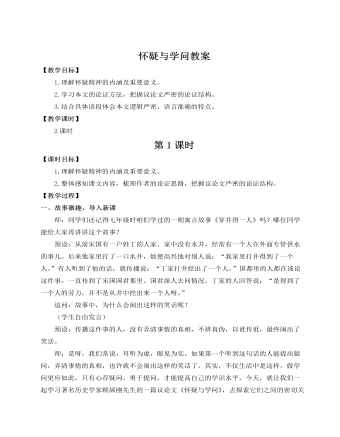
人教部编版语文九年级上册怀疑与学问教案
1.理解怀疑精神的内涵及重要意义。2.整体感知课文内容,梳理作者的论证思路,把握议论文严密的论证结构。【教学过程】一、故事激趣,导入新课师:同学们还记得七年级时咱们学过的一则寓言故事《穿井得一人》吗?哪位同学能给大家再讲讲这个故事?预设:从前宋国有一户姓丁的人家,家中没有水井,经常有一个人在外面专管供水的事儿。后来他家里打了一口水井,他便高兴地对别人说:“我家里打井得到了一个人。”有人听到了他的话,就传播说:“丁家打井挖出了一个人。”国都里的人都在谈论这件事,一直传到了宋国国君那里。国君派人去问情况。丁家的人回答说:“是得到了一个人的劳力,并不是从井中挖出来一个人呀。”追问:故事中,为什么会闹出这样的笑话呢?(学生自由发言)预设:传播这件事的人,没有弄清事情的真相,不辨真伪,以讹传讹,最终闹出了笑话。
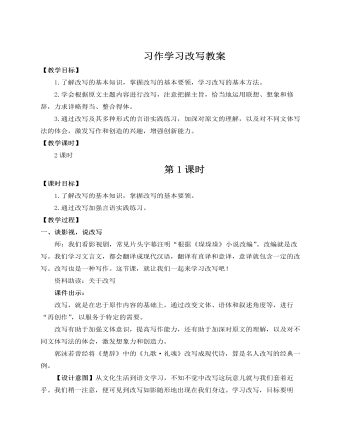
人教部编版语文九年级上册写作学习改写教案
有一天正午正走在黄泥冈上,他们又要喊歇,我自知这一带劫匪出没甚多,便催促他们快走,可他们却坐在地上不动了,任凭我怎样拿鞭抽打,他们也不起来,无奈之下,只得让他们歇会儿。不一会儿,来了一个卖酒的人过来,有人要买酒。被我阻止了,我说这酒里不知放了什么,还是不要喝的好。又一会儿来了几个贩枣的客商,先买了一桶酒,又把另一桶打开喝了一瓢。另一个客人见了,也拿瓢来舀酒。卖酒的见了,抢过瓢来,劈手将酒倒在桶里。殊不知,就在这时,蒙汗药被放进了桶里。老总管过来问我:“杨提辖,你看他们喝了都没事,我们也渴了,就买点吧。”我思量着,这一桶也被喝过,应该没事,只得同意了。于是他们便冲上去买酒,有人还给了我一瓢,我接下来喝了。这时我看他们一个个都头重脚轻栽倒在地上,心里暗叫:不好,中计了。但再想站起来,已经不可能了,看见那群“商人”,一个个笑着,我真是懊悔,没让队伍继续走,还有那些不听我话的人,为什么不听我话,又一次任务失败了,回去怎么交代……不一会儿我眼前一片漆黑,什么也不知道了。醒来后,周围一个人也没有,而生辰纲果然不见了,无奈之下,我只能逃走,却不知何处是终点……
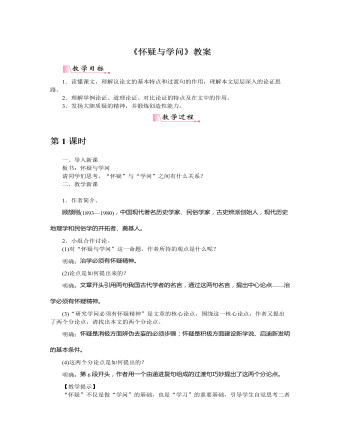
部编版语文九年级上册《怀疑与学问》教案
一、复习回顾、引入新课上节课,我们学习了《怀疑与学问》的内容,也学习了议论文结构的基本特征以及常用的论证方法,这节课我们重点学习议论文在论证论点过程中说理的层次,还要进一步理解议论文分析事理透辟,语言严密的特点。二、教学新课目标导学一:探究说理的层次,明确各段之间的关系请同学们细读课文,边读边思考句与句之间的关系,分组完成以下问题。1.本文论点是“治学必须有怀疑精神”,作者是如何阐述怀疑精神的?明确:对怀疑精神作者阐述得明确而透彻:所谓疑就是决不轻信,经过思考,分清是非,再决定信与不信;进而把怀疑科学地分为“怀疑”“思索”“辨别”三步。2.结合课文思考:作者是如何阐述“从怀疑到创新”这一治学过程的?明确:作者在进一步论证“怀疑是建设新学说、启迪新发明的基本条件”时,又把怀疑到创新的治学过程分析为“怀疑、辩论、评判、修正、创新”。作者通过举例、正反说理,使内容阐述得鞭辟入里,无懈可击。

